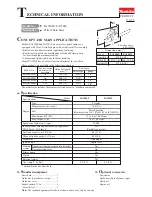
SKU 93009
For technical questions, please call 1-800-444-3353
Page 4
21. Check for misalignment or binding of moving parts, breakage of parts, and any other condi-
tion that may affect the tool’s operation. If damaged, have the tool serviced before using.
Many accidents are caused by poorly maintained tools.
22. Use only accessories that are recommended by the manufacturer for your model. Accessories
that may be suitable for one tool may become hazardous when used on another tool.
Service
23. Tool service must be performed only by qualified repair personnel. Service or maintenance
performed by unqualified personnel could result in a risk of injury.
24. When servicing a tool, use only identical replacement parts. Use of unauthorized parts or failure
to follow maintenance instructions may create a risk of electric shock or injury.
Specific Safety Rules
1.
Maintain labels and nameplates on the tool. These carry important information. If unreadable or
missing, contact Harbor Freight Tools for a replacement.
2.
Always wear ANSI approved safety impact eye goggles and face mask when using the tool.
Using personal safety devices reduce the risk for injury. Safety impact eye goggles and face masks
are available from Harbor Freight Tools.
3.
Maintain a safe working environment. Keep the work area well lit. Make sure there is adequate
surrounding workspace. Always keep the work area free of obstructions, grease, oil, trash, and other
debris. Do not use a power tool in areas near flammable chemicals, dusts, and vapors. Do not use
this product in a damp or wet location.
4.
Make sure to read and understand all instructions and safety precautions as outlined in this manual.
5.
When starting a hand-held power tool, always maintain a firm grip on the tool with both hands
to resist starting torque.
6.
Always keep the extension cord away from moving parts on the tool.
7.
Avoid unintentional starting. Make sure you are prepared to begin work before turning on the tool.
8.
Do not force the tool. This tool will do the work better and safer at the speed and capacity for which
it was designed.
9.
Never lay the tool down until the motor has come to a complete stop. The tool may create
unforeseen risk while the motor cycles down.
10. Never leave the tool unattended when it is plugged into an electrical outlet. Turn off the tool,
and unplug it from its electrical outlet before leaving.
11. Always unplug the tool from its electrical outlet before performing and inspection, mainte-
nance, or cleaning procedures.
WARNING! Some dust created by power sanding, sawing, grinding, drilling, and other construction
activities, contain chemicals known (to the State of California) to cause cancer, birth defects or other
reproductive harm. Some examples of these chemicals are: lead from lead-based paints, crystalline
silica from bricks and cement or other masonry products, arsenic and chromium from chemically
treated lumber. Your risk from these exposures varies, depending on how often you do this type of
work. To reduce your exposure to these chemicals: work in a well ventilated area, and work with
approved safety equipment, such as those dust masks that are specially designed to filter out
microscopic particles.
(California Health & Safety Code 25249.5, et seq.)






























